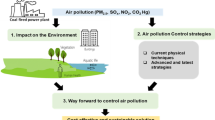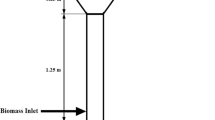Abstract
The effect of hydrogen injection on blast furnace operation and carbon dioxide emissions was simulated using a 1D steady-state zonal model. The maximum hydrogen injection rate was evaluated on the basis of the simulation of the vertical temperature pattern in the blast furnace with a focus on the thermal reserve zone. The effects of blast temperature and oxygen enrichment were also examined to estimate coke replacement ratio, productivity, hydrogen utilization efficiency, and carbon dioxide emission reduction. For blast temperature of 1200°C, the maximum hydrogen injection rate was 19.0 and 28.3 kg of H2/t of hot metal (HM) for oxygen enrichment of 2vol% and 12vol%, respectively. Results showed a coke replacement ratio of 3–4 kg of coke/kg of H2, direct CO2 emission reduction of 10.2%–17.8%, and increased productivity by up to 13.7% depending on oxygen enrichment level. Increasing blast temperature further reduced the direct CO2 emissions. Hydrogen utilization degree reached the maximum of 0.52–0.54 H2O/(H2O + H2). The decarbonization potential of hydrogen injection was estimated in the range from 9.4 t of CO2/t of H2 to 9.7 t of CO2/t of H2. For economic feasibility, hydrogen injection requires revolutionary progress in terms of low-cost H2 generation unless the technological change is motivated by the carbon emission cost. Hydrogen injection may unfavorably affect the radial temperature pattern of the raceway, which could be addressed by adopting appropriate injection techniques.
Similar content being viewed by others
References
F. Patisson and O. Mirgaux, Hydrogen ironmaking: How it works, Metals, 10(2020), No. 7, art. No. 922.
C. Hoffmann, M.V. Hoey, and B. Zeumer, Decarbonization Challenge for Steel, McKinsey & Company [2020-06-03]. https://www.mckinsey.com/industries/metals-and-mimng/our-insights/decarbonization-challenge-for-steel
K. Nishioka, Y. Ujisawa, S. Tonomura, N. Ishiwata, and P. Sikstrom, Sustainable aspects of CO2 ultimate reduction in the steelmaking process (COURSE50 project), part 1: Hydrogen reduction in the blast furnace, J. Sustainable Metall., 2(2016), No. 3, p. 200.
T. Skoczkowski, E. Verdolini, S. Bielecki, M. Kochański, K. Korczak, and A. Węglarz, Technology innovation system analysis of decarbonisation options in the EU steel industry, Energy, 212(2020), art. No. 118688.
D. Kushnir, T. Hansen, V. Vogl, and M. Åhman, Adopting hydrogen direct reduction for the Swedish steel industry: A technological innovation system (TIS) study, J. Cleaner Prod., 242(2020), art. No. 118185.
L. Holappa, A general vision for reduction of energy consumption and CO2 emissions from the steel industry, Metals, 10(2020), No. 9, art. No. 1117.
International Energy Agency (IEA), Iron and Steel Technology Roadmap: Towards more Sustainable Steelmaking, OECD/IEA, Paris, 2020.
H.Y. Sohn, Energy consumption and CO2 emissions in ironmaking and development of a novel flash technology, Metals, 10(2019), No. 1, art. No. 54.
V. Schmies, Green Steel: Review of Phase 1 of the Injection Trials, Thyssenkrupp [2021-02-02]. https://engineered.thyssenkrupp.com/en/phase-1-of-the-injection-trials/
Z.J. Tang, Z. Zheng, H.S. Chen, and K. He, The influence of hydrogen injection on the reduction process in the lower part of the blast furnace: A thermodynamic study, [in] A.A. Baba, L. Zhang, D.P. Guillen, N.R. Neelameggham, H. Peng, and Y.L. Zhong, eds., Energy Technology 2021: Carbon Dioxide Management and Other Technologies, Springer, Cham, 2021, p. 149.
H. Nogami, Y. Kashiwaya, and D. Yamada, Simulation of blast furnace operation with intensive hydrogen injection, ISIJ Int., 52(2012), No. 8, p. 1523.
C. Yilmaz, J. Wendelstorf, and T. Turek, Modeling and simulation of hydrogen injection into a blast furnace to reduce carbon dioxide emissions, J. Cleaner Prod., 154(2017), p. 488.
N. Barrett, P. Zulli, D. O’Dea, S. Mitra, and T. Honeyands, Replacement of pulverised coal injection (PCI) with hydrogen and its impact on blast furnace internal conditions, [in] Iron Ore Conference, Perth, 2021.
J. Tang, M.S. Chu, F. Li, Z.D. Zhang, Y.T. Tang, Z.G. Liu, et al., Mathematical simulation and life cycle assessment of blast furnace operation with hydrogen injection under constant pulverized coal injection, J. Cleaner Prod., 278(2021), art. No. 123191.
Y.T. Zhuo, Z.J. Hu, and Y.S. Shen, CFD study of hydrogen injection through tuyeres into ironmaking blast furnaces, Fuel, 302(2021), art. No. 120804.
J.A. de Castro, C. Takano, and J.I. Yagi, A theoretical study using the multiphase numerical simulation technique for effective use of H2 as blast furnaces fuel, J. Mater. Res. Technol., 6(2017), No. 3, p. 258.
B.I. Kitaev, Y.G. Yaroshenko, and V.D. Suchkov, Heat Exchange in Shaft Furnaces, Pergamon press, Oxford, 1967.
J. Gustavsson, Reactions in the Lower Part of the Blast Furnace with Focus on Silicon [Dissertation], Royal Institute of Technology, Sweden, 2004, p. 70.
Y. Hashimoto, Y. Sawa, Y. Kitamura, T. Nishino, and M. Kano, Development and validation of kinematical blast furnace model with long-term operation data, ISIJ Int., 58(2018), No. 12, p. 2210.
I.G. Tovarovskiy, Improvement and Optimization of Blast Furnace Operation Parameters, Metallurgiya, Moscow, 1987.
K.M. Bugayev, Representativeness of The Blast Furnace Zonal Balance, Metall. Min. Ind., 1991, No. 4, p. 28.
B.I. Kitayev, Blast Furnace Operation Control, UPI, Svierdlovsk, 1984.
A.N. Ramm, Modern Blast Furnace Process, Metallurgiya, Moscow, 1980.
V. Shatokha, Control of Hot Metal Quality Under Conditions of The Expansion of Fuel Base of Blast Furnace Ironmaking Based on Physicochemical Analysis of Slag Forming Processes [Dissertation], National Metallurgical Academy of Ukraine, Dnipropetrovsk, 1998, p. 304.
K.H. Ma, J.Y. Deng, G. Wang, Q. Zhou, and J. Xu, Utilization and impacts of hydrogen in the ironmaking processes: A review from lab-scale basics to industrial practices, Int. J. Hydrogen Energy, 46(2021), No. 52, p. 26646.
E.F. Vegman, Blast Furnace Handbook, Metallurgiya, Moscow, 1981.
S.A. Gavrilko, Study of The Effect of Physicochemical Properties of Fluxed Sinter on Smelting Processes in The Blast Furnace [Dissertation], Zaporozhie Industrial Institute, Zaporozhie, 1978, p. 199.
S.V. Shavrin and A.V. Chentsov, On the choice of equations for the analysis of heat exchange in blast furnace, [in] Intensification of Blast Furnace: Proceeding of the Conference on Theoretical Problems of Ironmaking, Moscow, 1963, p. 169.
Y.G. Yaroshenko and V.S. Shvydkyi, On the possible schemes of heat exchange in metallurgical shaft furnaces, Izvestiya Vuzov. Chernaya Metallurgiya, 1969, No. 10, p. 155.
S. Watakabe, K. Miyagawa, S. Matsuzaki, T. Inada, Y. Tomita, K. Saito, et al., Operation trial of hydrogenous gas injection of COURSE50 project at an experimental blast furnace, ISIJ Int., 53(2013), No. 12, p. 2065.
N.A. Gladkov, Analysis of the experience of the use of combined blast, [in] Fundamental and Applied Problems of Ferrous Metallurgy, Collection of Scientific Works, Issue 20, Institute of Ferrous Metallurgy, Dnipropetrovsk, 2009, p. 36.
Steelonthenet.com, European Met Coke Prices [2021-03-05]. https://www.steelonthenet.com/files/blast-furnace-coke.html
Sgh2energy.com, Economics [2021-03-05]. https://www.sgh2energy.com/economics
Hydrogen Council and McKinsey & Company, Hydrogen for Net-Zero: A Critical Cost-competitive Energy Vector, Hydrogen Council [2021-11-29]. https://hydrogencouncil.com/wpcontent/uploads/2021/11/Hydrogen-for-Net-Zero.pdf
K.M. Bugayev, Distribution of Gases in Blast Furnaces, Metallurgiya, Moscow, 1974.
A.A. Himmelfarb and K.I. Kotov, The Processes of Reduction and Slag Forming in Blast Furnaces, Metallurgiya, Moscow, 1982.
A. Babich, D. Senk, H.W. Gudenau, and K.T. Mavrommatis, Ironmaking, Textbook, Mainz GmbH Aachen, Aachen, 2008.
K.M. Bugayev, Oxidation of natural gas in near the tuyeres in blast furnace under various parameters of combined blast, Metall. Min. Ind., 1977, No. 1, p. 5.
K.M. Bugayev, On the pyrolysis of natural gas in blast furnace, [in] Works of Donetsk Research and Development Institute of Ferrous Metallurgy. Ironmaking, Metallurgiya, Moscow, 1969, p. 123.
Author information
Authors and Affiliations
Corresponding author
Additional information
Conflict of Interest
The author declares no conflicts of interest.
Rights and permissions
About this article
Cite this article
Shatokha, V. Modeling of the effect of hydrogen injection on blast furnace operation and carbon dioxide emissions. Int J Miner Metall Mater 29, 1851–1861 (2022). https://doi.org/10.1007/s12613-022-2474-8
Received:
Revised:
Accepted:
Published:
Issue Date:
DOI: https://doi.org/10.1007/s12613-022-2474-8




